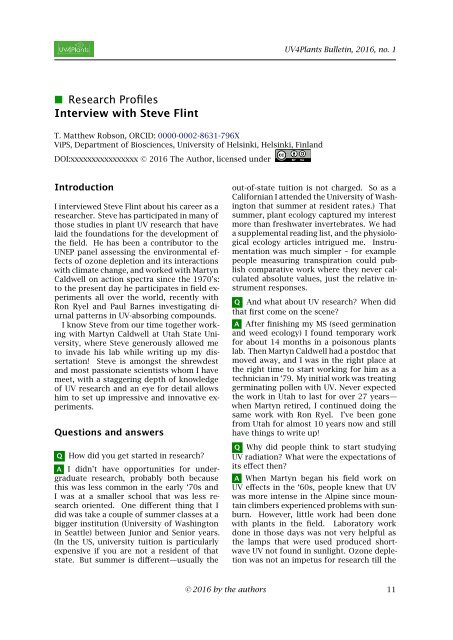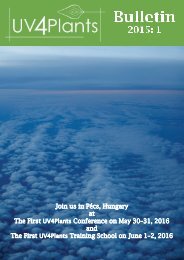UV4Plants Bulletin 2016:1
The Bulletin of the <a href="http://www.uv4plants.org>UV4Plants Association</a> is published two times per year. It is an open-access publication.
The Bulletin of the <a href="http://www.uv4plants.org>UV4Plants Association</a> is published two times per year. It is an open-access publication.
Create successful ePaper yourself
Turn your PDF publications into a flip-book with our unique Google optimized e-Paper software.
<strong>UV4Plants</strong> <strong>Bulletin</strong>, <strong>2016</strong>, no. 1<br />
Research Profiles<br />
Interview with Steve Flint<br />
T. Matthew Robson, ORCID: 0000-0002-8631-796X<br />
ViPS, Department of Biosciences, University of Helsinki, Helsinki, Finland<br />
DOI:xxxxxxxxxxxxxxxx © <strong>2016</strong> The Author, licensed under<br />
Introduction<br />
I interviewed Steve Flint about his career as a<br />
researcher. Steve has participated in many of<br />
those studies in plant UV research that have<br />
laid the foundations for the development of<br />
the field. He has been a contributor to the<br />
UNEP panel assessing the environmental effects<br />
of ozone depletion and its interactions<br />
with climate change, and worked with Martyn<br />
Caldwell on action spectra since the 1970’s:<br />
to the present day he participates in field experiments<br />
all over the world, recently with<br />
Ron Ryel and Paul Barnes investigating diurnal<br />
patterns in UV-absorbing compounds.<br />
I know Steve from our time together working<br />
with Martyn Caldwell at Utah State University,<br />
where Steve generously allowed me<br />
to invade his lab while writing up my dissertation!<br />
Steve is amongst the shrewdest<br />
and most passionate scientists whom I have<br />
meet, with a staggering depth of knowledge<br />
of UV research and an eye for detail allows<br />
him to set up impressive and innovative experiments.<br />
Questions and answers<br />
Q<br />
How did you get started in research?<br />
A I didn’t have opportunities for undergraduate<br />
research, probably both because<br />
this was less common in the early ‘70s and<br />
I was at a smaller school that was less research<br />
oriented. One different thing that I<br />
did was take a couple of summer classes at a<br />
bigger institution (University of Washington<br />
in Seattle) between Junior and Senior years.<br />
(In the US, university tuition is particularly<br />
expensive if you are not a resident of that<br />
state. But summer is different—usually the<br />
out-of-state tuition is not charged. So as a<br />
Californian I attended the University of Washington<br />
that summer at resident rates.) That<br />
summer, plant ecology captured my interest<br />
more than freshwater invertebrates. We had<br />
a supplemental reading list, and the physiological<br />
ecology articles intrigued me. Instrumentation<br />
was much simpler – for example<br />
people measuring transpiration could publish<br />
comparative work where they never calculated<br />
absolute values, just the relative instrument<br />
responses.<br />
Q And what about UV research? When did<br />
that first come on the scene?<br />
A After finishing my MS (seed germination<br />
and weed ecology) I found temporary work<br />
for about 14 months in a poisonous plants<br />
lab. Then Martyn Caldwell had a postdoc that<br />
moved away, and I was in the right place at<br />
the right time to start working for him as a<br />
technician in ‘79. My initial work was treating<br />
germinating pollen with UV. Never expected<br />
the work in Utah to last for over 27 years—<br />
when Martyn retired, I continued doing the<br />
same work with Ron Ryel. I’ve been gone<br />
from Utah for almost 10 years now and still<br />
have things to write up!<br />
Q Why did people think to start studying<br />
UV radiation? What were the expectations of<br />
its effect then?<br />
A When Martyn began his field work on<br />
UV effects in the ‘60s, people knew that UV<br />
was more intense in the Alpine since mountain<br />
climbers experienced problems with sunburn.<br />
However, little work had been done<br />
with plants in the field. Laboratory work<br />
done in those days was not very helpful as<br />
the lamps that were used produced shortwave<br />
UV not found in sunlight. Ozone depletion<br />
was not an impetus for research till the<br />
© <strong>2016</strong> by the authors 11



